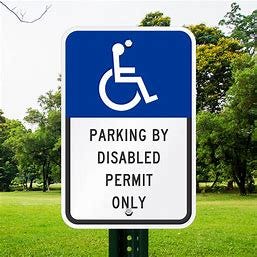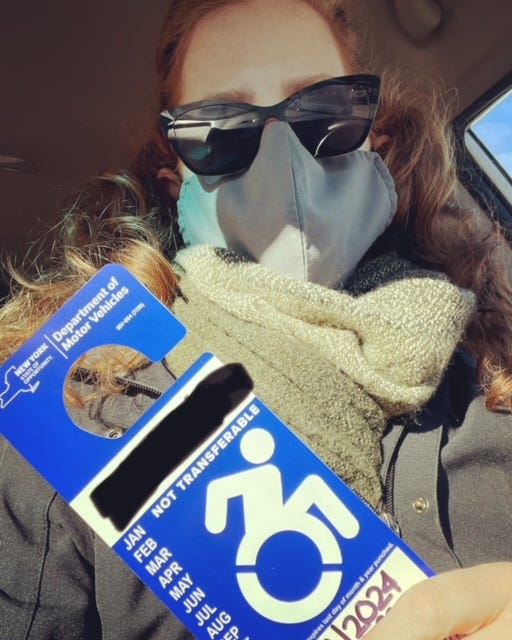🎵 Not as catchy as Joni’s version, I know.
Take a ride with me
In December 2021, about 18 months into my Long COVID journey, I swallowed my pride and finally applied for a disabled parking permit. It was long overdue, but it turns out it’s not the first time I’ve thought about parking spaces.
In the “before times”:
1. I used to work out for 30-60 minutes most days of the week; I’d do cardio and weightlifting at home and I also hiked, played competitive volleyball, and took tennis lessons. However, when it came to parking, I was the LAZIEST person you’d ever met. I routinely hunted for the closest spot I could get like it was some sort of game. My dear friend SueB (“SOO-bee”) used to say to me from the passenger seat, “you work out for two fucking hours a day, but god forbid you walk twenty feet more than you absolutely have to!” Ha ha. She’s the cutest. Here’s a picture of her adorable diminutive self not even clearing a parking meter:
She’s also coincidentally standing in front of a disabled parking space 🤯.
2. When I had to park anywhere regularly, I would often analyze which were the best parking spaces for my particular needs or concerns. For example, at the grocery store, I would park near the exit door, since on the way out of the store is when you’re wielding a heavy cart and it could be raining or your ice cream might be melting or you might have been employing ‘mind over bladder’ for the entire trip. You need to get out of the store, load up your goods, and keep it moving.
I worked at one non-profit where the CEO and I often got into long and detailed conversations about the mundane. We joked that we’d start a talk show one day that would be Seinfeldian in nature. A whole episode discussing toilet paper, that kind of thing. One day I told him my parking risk assessment for headquarters, and apparently, I took the mundane too far because he actually told me I was batshit crazy.
“You don’t park in the back of the building if you’re not leaving before dark, because it’s rapey. You don’t park alongside the gas station, because what if it blows up? Same with the spaces right up against our own building – what if it explodes? And you certainly don’t want to park along North Broadway because that part of the road is a curve and people act like they’re Mario Andretti on that road and one time at my old job, an elderly driver jumped the curb and hit a car parked on the street side of the parking lot, and so you should never take a spot in a parking lot that’s along a busy road. The only safe place to park in the full analysis is the side of the building where there are only trees, though even that presents its hazards – dents from acorns, bird shit, or a felled tree, to name a few.”
In practice, whenever I would pull into that work lot, I’d have to take an available spot that was somewhere acceptably low on the list of potential hazards. The two places I never parked were along that busy street and in the back of the building when it would be dark out. Rape and a Fast and Furious-style car flip both seemed more likely than the building blowing up.
You may be getting a feel for me as a chronic overthinker, and I’d say maybe you’re right but also humans have evolved with the propensity for logic and reasoning and why shouldn’t we use it for everyday things just as much as for employment or family problems and I probably should have ended this sentence after ‘overthinker.’
So, of course I’m writing a post about accessible parking and WOW, is it ever a topic that is ripe for a trained overthinker like me with a subspecialty in parking overthinking.
Parking for the disabled: a wide world of individual and societal issues
Before the placard
In my first year with long COVID (2020-2021), I was shuffling between work and disability leave and starting to see as many different doctors as my various issues necessitated. That meant driving (and parking) quite a bit. One place in particular – my local post-COVID center* – had an abysmal parking set-up. Nearly every available space was unreasonably far from the very busy building at most hours of the day. I was walking hundreds of yards in and out each time. My shortness of breath was at its worst around that time, and my fatigue was extremely bad too.
*I told my doctor there once that they should have dedicated parking spaces for anyone coming to the post-COVID center, since so many of us had breathing/fatigue issues. Poor planning on their part locating this center in a building like that.
By the end of 2021, after months of working with a great therapist whom I’ve written about in Is Your Underwear Clean Yet? and who also has ME/CFS, I had finally gotten to a place of acceptance with this illness and with admitting that I needed help and that it was okay to access it. (In hindsight, the impostor syndrome I still have to this day about possessing and using this placard started way before I decided to get it. More on this soon).
I also had a better understanding of pacing, and the idea that using up my precious energy by walking much further than I have to from my car to any building was taking away from other things I may need or want to do later in the day. I filled out the form and had my doctor sign it.
Getting the placard
I went to my local Town Hall on December 20, 2021 to hand in the form and obtain the placard. Even walking into the building, I felt some blend of embarrassment and shame. As a member of the town’s conservation advisory council, I had occasion to be in this building on a monthly basis since 2013. The thought of running into the staff people who were part of the council and worked at Town Hall filled me with dread. Would I have to explain why I was at Town Hall in the middle of the day instead of in the evenings (our usual meeting time)? If I did, would I be questioned or doubted about needing the placard?
And even though I filled out the form and my doctor signed off, I was still worried about what would happen when I approached the window and turned in my form. Was there some sort of evaluation or analysis they needed to do to assess whether my need for a placard was legit?
As is true with most irrational fears, what I was dreading didn’t happen. The woman who assisted me at the window was lovely. She took my form, walked away for a few minutes, and returned with a numbered placard. She also explained to me that if I should need it for longer than the three years, all I had to do was come down and get it extended – no need for an additional doctor’s attestation.
WOW. After a year and a half of gaslighting doctors and difficult insurance processes and denied disability applications and fighting for the world to see and hear and believe me and all of the other long haulers, could it really be this simple, this validating, this easy on the disabled?
I’m sure I walked out as quickly as I could, both to avoid my colleagues on the council and also to make a fast getaway in case nice-woman-at-the-window realized she’d gone soft and needed to reel me back in.
When I got to my car, I felt some measure of relief and accomplishment. I did it; I overcame my fears to access the help I needed and deserved. I snapped this pic:
After the placard
There are ‘events’ I have used to demarcate my life, with the big ones being the befores and the afters of: my parents’ deaths, meeting Baldy, and contracting COVID. Although the parking placard seems insignificant by comparison, there were distinct worldviews to before and after obtaining the placard.
Before the placard (really, before I developed long COVID), I admittedly didn’t give too much thought to accessible parking. I had it ingrained in my head that this parking wasn’t for me, under my current life circumstances. I judged and cursed those who parked in these spaces without a placard. As anecdotal as this is, I can tell you that most of the time I’ve seen this happen, it’s been a douchey young guy in his stupid truck or tricked out Honda, for example. Entitlement and privilege and “my shit don’t stink because I use Axe body spray” just oozing out of their dumb, douchey pores.
But after the placard? There were reactions I had pertaining to myself and my use of the placard. And then the longer I had the placard and started paying close attention to every building and parking lot I encountered, the parking overthinker of yesteryear re-emerged.
Initially, I was painfully aware of my impostor syndrome. I had this placard that I hadn’t really earned because it was far too easy to obtain, easier than it should have been. When you are conditioned to believe that anything related to our medical systems and government programs will be unnecessarily, over the top challenging and let’s face it, often downright demoralizing, you start to think something is seriously wrong when that doesn’t happen.
And also, was I really sick or disabled enough to warrant this placard? (Yes, I already went through this self-doubt before I even applied for the placard, but now that I had it, well who the hell was I to think I deserved to use it? Especially when there are folks out there with visible, mobility-related disabilities?).
I gave my impostor ‘rules’ for when and how I could use the placard. In the beginning, that consisted of “if there aren’t any ‘regular’ parking spaces available near the entrance, I’ll use an accessible space, but only if there is more than one available in case someone comes along who needs it more than I do.”
Abiding by such rules forced me to pay very close attention when I pulled into a parking lot and to be ready to make a quick determination about where I was going to park. This is when I began to analyze the accessible parking situation of every building I came upon. Here is what I noticed:
1) Many, many buildings do not seem to have nearly enough accessible spaces. A quick Google search told me that in the U.S., the Americans with Disabilities Act (the ADA) dictates accessible parking requirements. The ratios have a wide swing though: a parking lot, for example, can have as few as 25 and as many as 50 total spaces and still only be required to have two accessible spaces. This is probably why it often seems like there just aren’t enough accessible spaces available. I notice this when trying to apply my rules and often finding it hard to do since much of the time, there just isn’t even an option for me to take an accessible space.
I don’t know what the ADA bases its requirements on, or if there is ever any review of the ratio requirements after a national survey on disabilities (like this one I just filled out this week). We know, for example, that the sheer number of disabled people in the U.S. increased dramatically because of COVID alone (by 1.2 million people between 2020 and 2021). There probably wasn’t enough accessible parking even before the pandemic, but now? Forget it.
2) A lot of the time, the accessible parking isn’t located within easy access to the building entrance. I noticed this one because there have been enough times when I arrived at a building ready to apply my rules, but I didn’t wind up having to because there were open ‘regular’ spaces closer to the entrance than any of the so-called accessible spaces.
For example, the other day I pulled into the parking lot of my bank to get cash. I briefly toyed with the idea of going inside, but then decided to just use the drive-thru ATM. But before that decision, I quickly analyzed the accessible vs. regular scene. Sure, the accessible spaces were in the row of spaces closest to the building. But of that row of spaces, they were the furthest from the door. Maybe there’s an engineering reason for this? I don’t know. The ADA states that “accessible parking spaces must be located on the shortest accessible route to the accessible entrance.” It doesn’t always seem like this is adhered to by property owners.
3) The buildings that (anecdotally) seem to be the worst offenders of #1 and #2? You guessed it: medical facilities. Logic would seem to suggest that parking lot ratio requirements should be different for healthcare facilities, since many disabling conditions require ongoing care. And indeed, the ADA site tells us that hospitals, rehab centers, and outpatient physical therapy facilities have higher ratio requirements than other types of facilities.
So why is it that the places where I most often have trouble getting an accessible spot are medical in nature? And the larger the facility, the harder it is to nab one. It just doesn’t seem that the number of accessible spaces is proportionate to the level of need at some buildings, despite the requirements.
My cardiologist is located in a building adjacent to the largest medical center in our area; the kind to which victims of serious car accidents get airlifted. The medical center and the adjacent medical office building share the same parking lots. Forget accessible parking (I think I have gotten a spot once and I’ve been there at least a dozen times since I got my placard); all of the parking spaces in these lots are too far away from the building and there aren’t enough safe or accessible walkways from these lots to the building. Ambulating individuals have carved out a dirt path through a grassy median in an effort to walk more directly from one of the lots into the building. That should tell the architects and owners something.
Bringing this in for a landing
It really is amazing how much more you notice injustices or poor planning once it applies to you (no shit, right?).
In some ways, getting and using my placard has had me feeling like Dorothy and Toto emerging from their black and white Kansas tornado house into technicolor Munchkinland.
By that I don’t mean that everything became awesome, but that I could finally see things so clearly that I never saw before. (There is probably a better movie reference here; you cinephiles out there can weigh in. Yes, that includes you, my dearest, baldest husband).
Being able to take a regular parking space is a privilege for the able-bodied. And having a placard is its own kind of privilege for some of us. There are days I feel like I don’t need to use it, even when there are plenty of accessible spaces available. Since the early days, I have relaxed my rules around using it. Now I am much more self-compassionate, checking in with my body on my way to a place and asking myself what it needs that day. If I am especially fatigued, or if I know I have to conserve spoons for an activity later in the day (even simply showering), I may opt to take an accessible space, even if it’s the only one left.
And there have admittedly been days when I maybe don’t feel severely fatigued and it’s raining and I want to be as close to a building’s entrance as possible. Sometimes I feel guilty whipping out the placard in such situations. However, I remind myself that I don’t (yet) have any days where I feel GOOD. I am, in truth, energy-disabled every single day.

One other thing: when I first got the placard, I braced myself for judgmental glares and comments from some people who might deem me as not disabled “enough” to take up an accessible space. We’ve all heard those horror stories. For a long time, I even made sure to look particularly hang-doggy and to walk slowly from and to my car. I have even played out how I would respond in these scenarios (I thought it might be particularly powerful to start telling the person the whole sordid saga of my long COVID, including test results, and when they inevitably lose interest and regret ever having said anything to me in the first place, hitting them with a “then mind your own fucking business and keep it moving.” 😆😈).
The good news? Have faith in humanity (for now) because nothing like this has happened to me in the almost two years since I got the placard. I’ve even dropped the hang-dog act, because I don’t owe anyone a performance of my invisible disability.
What do you think?
The other way to understand something problematic besides having your own personal wakeup call is to have someone with lived experience of the problem share with you what it’s like and then (hopefully) your empathic humanity sets in and you start to see the reality of what they’ve described in a new way.
Maybe you have already been disabled and you have had your own understanding and analysis of accessible parking (or accessibility in general). Maybe you don’t drive, or maybe you’ve not had reason to consider any of this until now. It’s all good; this is how life goes.
I’d love to hear what this post brings up for you? Meet me in the comments.
Stick around for…
🥳 The After-party 🥳
Announcements, links to articles and studies, recommendations and shout-outs, and miscellany joy and/or tomfoolery.
🥱 Long COVID (and ME/CFS) fatigue are not like other kinds of fatigue. Check out Covid Q&A with Keith to learn more. He’s a professor and medicinal chemist and he explains things clearly.
🗣️ Register for LONG COVID TREATMENT IN AN ADULT OUTPATIENT PSYCHOLOGY SERVICE, a talk given on October 13th at 10am Eastern by William Tsang, PsyD, staff psychologist specializing in neuropsychology and rehabilitation psychology at NYU Langone Health Rusk Rehabilitation. This presentation offers evidence-based approaches in addressing the cognitive, behavioral, and psychological sequelae of COVID-19 infection. In addition to research literature and clinical experiences from an outpatient rehabilitation service, participants are also encouraged to share personal experiences.
📢 Massachusetts ME/CFS and FM Association (known as “Mass ME”) is having the incomparable Ed Yong speak at their annual meeting on October 28th from 1-3pm Eastern (note, there is a $10 fee to attend this virtual talk, though Mass ME will waive it for anyone experiencing hardship). His talk is called ME/CFS: Changing the Narrative. From the Mass ME website: Ed Yong is a celebrated science journalist whose coverage of ME/CFS and Long COVID for The Atlantic has been groundbreaking.
👩🏻🦰 Personal note: Ed Yong’s article from June 2020 was one of the first in-depth long COVID pieces published in the media and it helped me not only figure out what was wrong but connect to other long haulers. His latest, on long COVID fatigue, was also excellent.
💰 You may have seen the article on Social Security overpayments to the disabled in my post last week, The Rodeo. Here is an apparent follow-up from the SSA: Social Security Acting Commissioner Kilolo Kijakazi Directs Review of Overpayment Procedures and Policies
👩🏾 Register for Black Women and Families: From Dismissed to Diagnosed, taking place on October 14th at 3pm ET. Get practical guidance and hear the stories of three Long COVID advocates and patients who have tremendous experience navigating the medical and benefits systems.
🥇 Winner of the week: if you’ve been with The Tonic for a bit (formerly Long COVID and ME), you know that we love us some Simone Biles. She and her U.S.A. Gymnastics teammates have been crushing it lately, winning a record-breaking seventh consecutive world title. We are seeing the best gymnastics of our time - can’t wait for the 2024 Olympics ❤️🔥
🤦🏼♀️ Buffoon of the week: I mean, c’mon. You can’t sell your soul to the devil and expect the other party to save your dumb ass. Kevin McCarthy, you reap what you sow, you spineless buffoon.
🐈⬛ 💩 And finally, it’s this week’s Cat Dump.
Short back story: Zira (our elder stateswoman - the fluffy little calico girl on the left) always wants Fritzy (tabby on the right) to lick her head. She butts it into his mouth often, but he doesn’t usually have any interest. This makes us sad because our late kitty Speck used to lick her head and since he’s been gone, no one has taken up the job. Until now. Fritzy was finally indulging her, and so sweetly!
But then he stopped and jutted his leg out to groom it, which she mistook as an act of aggression and she was like, “get the fuck out of here with that shit!” 😡😆. Sound up if you want to hear my reactions in real time.



















Loved this! It brought to mind my first experience booking special assistance and wheelchair accompaniment for traveling. Even though walking through airports had left me bedbound for weeks, I kept telling myself I wasn't "disabled enough." It takes a lot of unlearning and retraining ourselves to accept the tools at our disposal and you captured this well 😊.
LOVED this article! After 3 years of LC I just received my placard last week. I haven’t used it yet because I am currently too ill to drive myself, but I have all of those same anxieties. I keep wanting to put stipulations on when I do/don’t use it but many times I don’t know I need it until after I perform the task at hand. Hearing your experience definitely helps me say Fuck it! After 3 years of hell, I’ve earned this!! ❤️